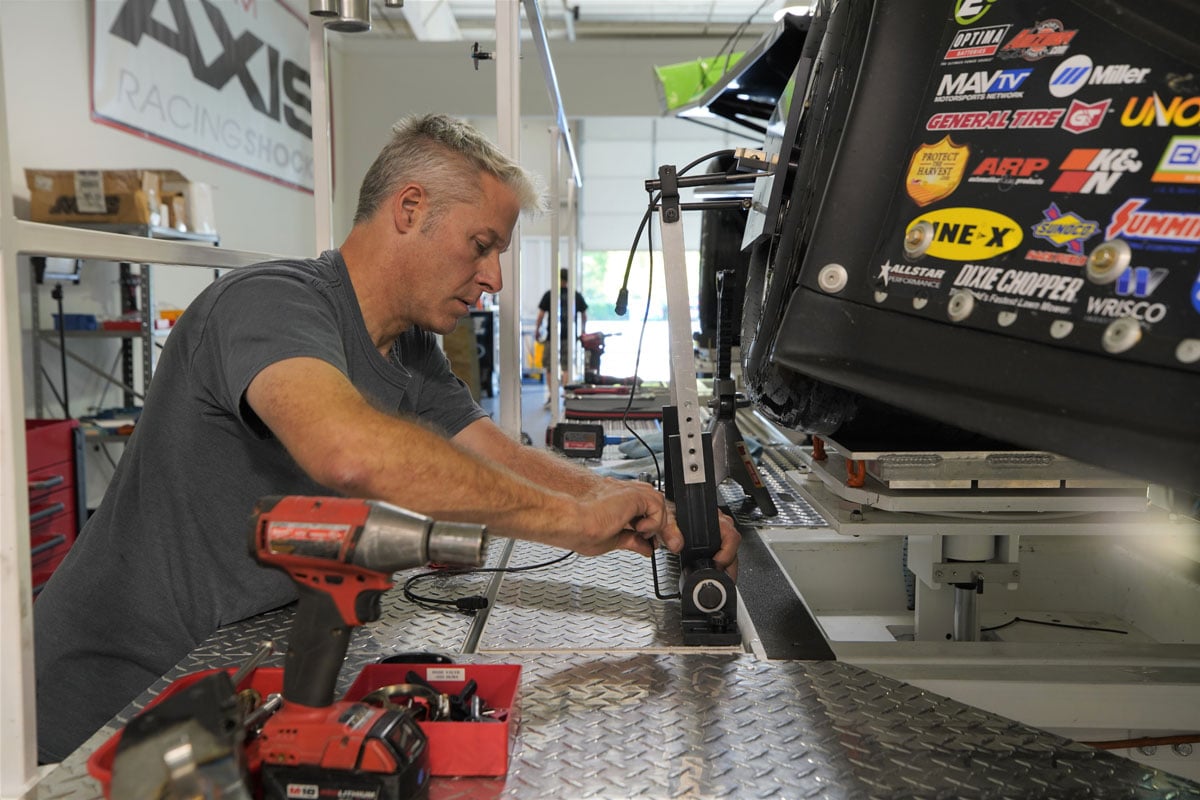What NOT to Do When Setting Up Your Racing Suspension for Dirt

April 4, 2022

You could be in the middle of the pack or standing on the podium.
That’s the difference a badly or properly tuned racing suspension can make. Every track and night is different. And you’re different. So it’s crucial to set up your vehicle with precision and care.
The playing field is level for the most part. Most vehicles are similar according to rules and regulations, and many teams invest in quality components, so what you can do with the tunable elements of your car could give you a competitive advantage.
In this article, we’ll highlight potential pitfalls while tuning your suspension and how to avoid them.
Setting Up Your Racing Suspension for Dirt: What NOT to Do
Horsepower and muscle used to rule dirt racing. Not anymore.
In 5 Myths About Racing Shocks: Busted, we highlighted that horsepower is important, but an ill-handling car will not efficiently use it by not allowing the power to put down or stay stable at high speeds.
Apart from ride height and droop rules, there is lots of freedom when it comes to racing suspension setup.
Get it right, and you might outperform the competition.
Check out: The Dirt Late Model Shocks that Winners are Using Right Now
#1: (Don’t) Forget to Use Your Dyno Graph
Make sure your shock supplier provides you a dyno graph of YOUR shocks as they were built (not a generic graph that shows “typical” adjustment ranges). It proves that the shocks were properly built to your specifications.
You also need to know your standard settings and how to properly set the adjusters to those settings.
You should understand what the graph is showing you. To many, a dyno graph might look like many squiggly lines on a piece of paper. But you should talk to your shock supplier about what side of the graph is the bump (compression) and what side is rebound (extension).
Ask them to explain the “low-speed” and the “high-speed” areas and what part of these ranges your adjuster will affect.
FREE DOWNLOAD: How to Read a Shock Dyno Graph
In this free download, we outline how to read a dyno graph and, more importantly, what it can tell you about how your shock is performing.
Want to learn more about Dynos? Check out: Why the S-Link Dyno is the Best Shock Dyno for Motorsports
#2: (Don’t) Fit it and Forget About it
Make sure you understand how your shocks work.
Which adjuster is which? What do they do? So many people buy a shock and waste a great deal of time turning the wrong knob or getting confused about how to make changes that will help them on track.
If you have questions, reach out immediately to your shock supplier before you get too far down the trail and waste valuable track time.
We also recommend that you keep notes for shock changes made to accommodate changing track conditions, and don’t forget to reset back to starting baseline before the next race.
Check out our FREE DOWNLOAD: Shock Build and Shock Setup/Lap Time Worksheet
In this free download, we provide both our Standard Shock Build Sheet, which is a great way to keep all your shock builds organized, and a Setup/Lap Time Sheet, a great tool to help improve your communication and record keeping of your chassis setup.
#3: (Don’t) Skimp on the Setup
If you’re running a non-gas shock (twin tube) or emulsion shock, make sure you check with your supplier about the proper orientation of the shock on the car (shaft up or shaft down).
Make sure your shocks are mounted properly. Depending on the shock design, the way it is mounted will change the shock curve and function dramatically. The body’s spherical bearing should be free, not bound up, and able to move easily. Make sure the shock and spring assembly are not rubbing on the frame.
The above criteria must be maintained regardless of the position of the steering.
#4: (Don’t) Ignore Ride Height
Make sure your ride heights are correct first.
So many racers chase their tails trying to address an issue on the car with shocks and springs when the real issue is that the ride heights are incorrect or improperly set, which can cause the car to mishandle.
#5: Maintenance (Isn’t) Optional
Shock maintenance is critical. It could be the difference between using your shocks for years or needing to buy multiple pairs at a great cost.
Post-Race: Clean & Inspect
Always check the condition of your racing suspension and shocks after each event. Is the shaft straight? Is the body dented? Is the shaft bead-blasted or rock chipped and causing a leak?
Basic post-race inspection is key to ensuring you don’t have an undetected issue that can lead to poor or inconsistent performance on track.
We also recommend that you check for dead spot near full extension.
And, always check your shocks on a dyno throughout the year, especially if you’re involved in an incident. The dyno will pick up on any issues and make sure your baseline is what you think it is.
FREE DOWNLOAD: How to Read a Shock Dyno Graph
In this free download, we outline how to read a dyno graph and, more importantly, what it can tell you about how your shock is performing.
Gas Pressure
You also want to include gas pressure in routine maintenance. When checking the gas pressure on their shocks, many people mistakenly let the pressure out or get a false reading from the gauge as the gas fills the gauge line.
Always be prepared to reset the gas pressure after you check it, and have a nitrogen bottle handy to repressurize the shock to the desired charge.
Bump Stops
Bump stops don’t last forever! Because bump stops are made from foam or rubber, they are porous and under constant abuse. Over time, they will start to lose their rate or develop tears.
Check their condition regularly. Get them rated from time to time. Toss them and get new ones if they start to drift in rate or height.
#6: (Don’t) Get Carried Away
Some shocks have cockpit adjusters to allow the driver to make changes during yellows or in the pits. Be careful to make small changes, as it is easy to dial yourself out of the window.
Always know where your baseline setting is so you can easily return to it.
Setting Up Your Racing Suspension for Success
Nailing the basics of your racing suspension is paramount to your success, and shocks are no different. From the moment you order them, you want to know how they work, and more importantly, how they work in your application, and that they’re set up for your style and preferences.
The Penske Racing Shocks S3 program closes the gap on your competition by combining the right hardware for your application, personalized shock setup, and continued backend support.


%20(1).png?width=1080&height=1080&name=Heritage%20Cruiser%20Shock%20-%20IG%20(1)%20(1).png)